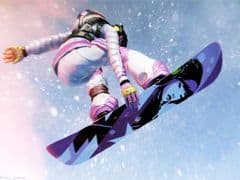Video Gamer is reader-supported. When you buy through links on our site, we may earn an affiliate commission. Prices subject to change. Learn more
Val Thorens. Makalu. Snowbird. Killington. Whistler. Kilamanjaro. Everest. In EA’s SSX reboot, you can shred all of them, as well as any other mountain you care to think of. Using topographical satellite data from NASA, SSX allows players to take to the slopes of any significant mountain range in the world. By punching in the longitude and latitude co-ordinates of a mountainous region, the game will create a tangible representation of the area in 28 seconds.
This is arguably the most innovative feature to come out of E3 this year.
That resort in the Alps where you went on holiday with your parents last year? You can revisit it here and trick off all the ramps and drops you didn’t have the balls to in real life. The run you’ve seen professionals tearing up in your favourite snow board videos? You can bomb down those badboys just as easily. Todd Batty, creative producer at EA Canada is well aware how hugely impressive the feature is, and was giddy with excitement to be explaining how it all works for the first time.
Batty explains that a feature of this magnitude, with such a vast wealth of content, needs a very particular type of UI in order to navigate. He references Google Earth as the solution to this problem. A 3D globe replaces conventional 2D interfaces, allowing players to zoom in on any range on planet earth. From here, you can hone in further and choose specific peaks to drop off and start playing.
Batty chooses Makalu as an example; the fifth largest mountain in the world. Mac, Elsie and fan favourite Kaori all begin their descents, each hoping to find the quickest route to the bottom. “There are no fences, no invisible walls and no barriers,” explains Batty. “If you can see it, you can ride it”.
NASA satellite data is just one of the new features coming to SSX. The second most important revelation to come out of the presentation concerns the powdery white stuff itself. Batty explained that the game will constantly analyse the effect your board is having on the snow. When the force you’re exerting on it exceeds its ‘stability rating’, the snow underneath will fall loose. Depending on how fast you’re travelling and how high you land on it from, you can trigger anything from a few loose flakes to a full on avalanche.
By way of example, Batty shows us a live demo of Kaori – who won her place in the game in a Facebook competition – bombing down a slope in Alaska. After launching herself off a particularly large kicker, extending the length of her air time with the new wing suit, she eventually reunites with the powder. After falling from such a hefty height (500ft we’re told) you can imagine the impact.
A sizeable amount of snow is dislodged, but Kaori keeps her cool and carves down the remainder of the mountain unphased. Behind her, however, the snow is quickly gaining momentum, looming like a huge white tidal wave. It swallows her alive.
This was actually a specific challenge in the game – to see how far down the treacherous mountain you could make it before getting wiped out. It’s one of nine ‘Deadly Descent’ challenges, what Batty affectionately refers to as the game’s ‘boss battles’. The words Deadly Descent might have been dropped from the title, but the concept of huge drops and dangerous consequences still plays a big role in the game.
“It’s Burnout on snow” offers Batty at one point during the presentation; an analogy I welcome with open arms.
With no mention of Autolog during the demo, I asked whether we could expect EA’s revolutionary social feature to make an appearance. Grinning knowingly the whole time, Batty remained tight-lipped, but did reveal that the online features would ‘not what you’d expect’ them to be. He explained that more would be revealed at Gamescom in August.
After leaving the presentation, I got to play the game for myself. Interestingly, SSX makes use of two control schemes mapped to the same pad. If you’re an old school Tony Hawk/SSX Tricky kind of person, you’ll probably prefer to use tricks mapped to the buttons. If, however, you’ve been converted by the likes of Skate, you’ll probably prefer the left-stick. I stuck to the buttons for the most part, but stick controls quickly started to feel more natural. I’m not sure which method I’ll permanently adopt.
The trick system itself is remarkably similar to SSX Tricky’s. It’s named after it, in fact: Tricky. Like its PS2 predecessor, you can string tricks together to build up your Tricky meter, which allows the use of more impressive ‘uber moves’. These could be pulled off by flicking the left-stick twice in any given direction. While the tricks I saw weren’t quite as ridiculous as SSX Tricky’s – Mac break-dancing on his board was a particular favourite of mine – they were reassuringly over the top.
There’s still a lot left to learn about the new SSX, mainly in the form of the social features that will ultimately define it, but it seems to be heading in a very interesting direction indeed. To use horrendously clichéd boarder lingo: I’m stoked, dude.
SSX is due for release on Xbox 360 and PlayStation 3 in January 2012

/https://oimg.videogamer.com/images/ff72/ssx_deadly_descents_2.jpg)